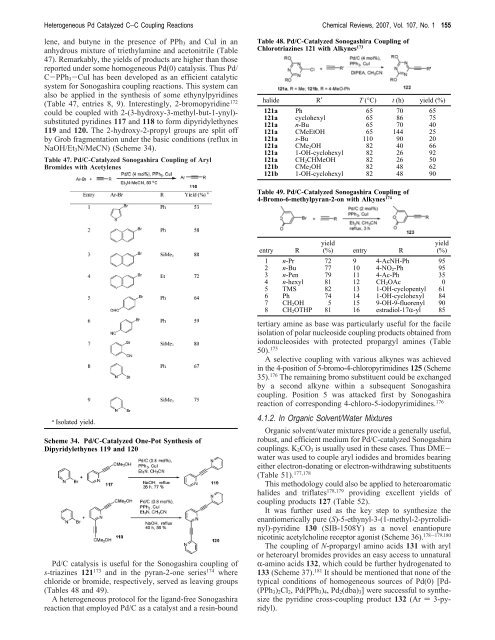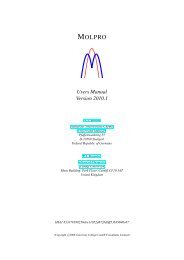Carbon−Carbon Coupling Reactions Catalyzed by Heterogeneous ...
Carbon−Carbon Coupling Reactions Catalyzed by Heterogeneous ...
Carbon−Carbon Coupling Reactions Catalyzed by Heterogeneous ...
Create successful ePaper yourself
Turn your PDF publications into a flip-book with our unique Google optimized e-Paper software.
<strong>Heterogeneous</strong> Pd <strong>Catalyzed</strong> C−C <strong>Coupling</strong> <strong>Reactions</strong> Chemical Reviews, 2007, Vol. 107, No. 1 155<br />
lene, and butyne in the presence of PPh3 and CuI in an<br />
anhydrous mixture of triethylamine and acetonitrile (Table<br />
47). Remarkably, the yields of products are higher than those<br />
reported under some homogeneous Pd(0) catalysis. Thus Pd/<br />
C-PPh3-CuI has been developed as an efficient catalytic<br />
system for Sonogashira coupling reactions. This system can<br />
also be applied in the synthesis of some ethynylpyridines<br />
(Table 47, entries 8, 9). Interestingly, 2-bromopyridine172 could be coupled with 2-(3-hydroxy-3-methyl-but-1-ynyl)substituted<br />
pyridines 117 and 118 to form dipyridylethynes<br />
119 and 120. The 2-hydroxy-2-propyl groups are split off<br />
<strong>by</strong> Grob fragmentation under the basic conditions (reflux in<br />
NaOH/Et3N/MeCN) (Scheme 34).<br />
Table 47. Pd/C-<strong>Catalyzed</strong> Sonogashira <strong>Coupling</strong> of Aryl<br />
Bromides with Acetylenes<br />
a Isolated yield.<br />
Scheme 34. Pd/C-<strong>Catalyzed</strong> One-Pot Synthesis of<br />
Dipyridylethynes 119 and 120<br />
Pd/C catalysis is useful for the Sonogashira coupling of<br />
s-triazines 121 173 and in the pyran-2-one series 174 where<br />
chloride or bromide, respectively, served as leaving groups<br />
(Tables 48 and 49).<br />
A heterogeneous protocol for the ligand-free Sonogashira<br />
reaction that employed Pd/C as a catalyst and a resin-bound<br />
Table 48. Pd/C-<strong>Catalyzed</strong> Sonogashira <strong>Coupling</strong> of<br />
Chlorotriazines 121 with Alkynes 173<br />
halide R′ T (°C) t (h) yield (%)<br />
121a Ph 65 70 65<br />
121a cyclohexyl 65 86 75<br />
121a n-Bu 65 70 40<br />
121a CMeEtOH 65 144 25<br />
121a s-Bu 110 90 20<br />
121a<br />
121a<br />
CMe2OH<br />
1-OH-cyclohexyl<br />
82<br />
82<br />
40<br />
26<br />
66<br />
92<br />
121a<br />
121b<br />
121b<br />
CH2CHMeOH<br />
CMe2OH<br />
1-OH-cyclohexyl<br />
82<br />
82<br />
82<br />
26<br />
48<br />
48<br />
50<br />
62<br />
90<br />
Table 49. Pd/C-<strong>Catalyzed</strong> Sonogashira <strong>Coupling</strong> of<br />
4-Bromo-6-methylpyran-2-on with Alkynes 174<br />
entry R<br />
yield<br />
(%) entry R<br />
yield<br />
(%)<br />
1 n-Pr 72 9 4-AcNH-Ph 95<br />
2 n-Bu 77 10 4-NO2-Ph 95<br />
3 n-Pen 79 11 4-Ac-Ph 35<br />
4 n-hexyl 81 12 CH2OAc 0<br />
5 TMS 82 13 1-OH-cyclopentyl 61<br />
6 Ph 74 14 1-OH-cyclohexyl 84<br />
7 CH2OH 5 15 9-OH-9-fluorenyl 90<br />
8 CH2OTHP 81 16 estradiol-17R-yl 85<br />
tertiary amine as base was particularly useful for the facile<br />
isolation of polar nucleoside coupling products obtained from<br />
iodonucleosides with protected propargyl amines (Table<br />
50). 175<br />
A selective coupling with various alkynes was achieved<br />
in the 4-position of 5-bromo-4-chloropyrimidines 125 (Scheme<br />
35). 176 The remaining bromo substituent could be exchanged<br />
<strong>by</strong> a second alkyne within a subsequent Sonogashira<br />
coupling. Position 5 was attacked first <strong>by</strong> Sonogashira<br />
reaction of corresponding 4-chloro-5-iodopyrimidines. 176<br />
4.1.2. In Organic Solvent/Water Mixtures<br />
Organic solvent/water mixtures provide a generally useful,<br />
robust, and efficient medium for Pd/C-catalyzed Sonogashira<br />
couplings. K2CO3 is usually used in these cases. Thus DMEwater<br />
was used to couple aryl iodides and bromides bearing<br />
either electron-donating or electron-withdrawing substituents<br />
(Table 51). 177,178<br />
This methodology could also be applied to heteroaromatic<br />
halides and triflates178,179 providing excellent yields of<br />
coupling products 127 (Table 52).<br />
It was further used as the key step to synthesize the<br />
enantiomerically pure (S)-5-ethynyl-3-(1-methyl-2-pyrrolidinyl)-pyridine<br />
130 (SIB-1508Y) as a novel enantiopure<br />
nicotinic acetylcholine receptor agonist (Scheme 36). 178-179,180<br />
The coupling of N-propargyl amino acids 131 with aryl<br />
or heteroaryl bromides provides an easy access to unnatural<br />
R-amino acids 132, which could be further hydrogenated to<br />
133 (Scheme 37). 181 It should be mentioned that none of the<br />
typical conditions of homogeneous sources of Pd(0) [Pd-<br />
(PPh3)2Cl2, Pd(PPh3)4, Pd2(dba)3] were successful to synthesize<br />
the pyridine cross-coupling product 132 (Ar ) 3-pyridyl).












![Hetero [6+3] Cycloaddition of Fulvenes with N-Alkylidene Glycine ...](https://img.yumpu.com/35423358/1/190x245/hetero-6-3-cycloaddition-of-fulvenes-with-n-alkylidene-glycine-.jpg?quality=85)




